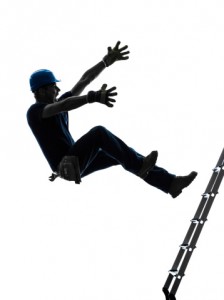Protect Yourself and Your Coworkers from Falls
 We all know that working from heights and near unprotected sides, edges, and openings is dangerous. But are you doing everything you can to protect yourself and your coworkers from falls? Injuries from falling can range from simple sprains to concussions and even death. And falls can happen at any time as the result of multiple causes:
We all know that working from heights and near unprotected sides, edges, and openings is dangerous. But are you doing everything you can to protect yourself and your coworkers from falls? Injuries from falling can range from simple sprains to concussions and even death. And falls can happen at any time as the result of multiple causes:
- Poorly positioned ladders
- Unstable working surfaces
- Misuse of fall protection
To avoid injury or worse, ensure that you and your coworkers are up to date on OSHA’s fall protection regulations.
Remember, anytime a worker is four feet or higher off the ground, he or she must be protected. Don’t fall prey to safety regulation myths. They can give a false sense of security, leading to serious injuries. Here are some examples of fall safety misconceptions:
- Following the six-foot rule ensures safety. This myth has people believing that an OSHA regulation states that you are safe as long as you are six feet from an edge. In reality, OSHA has determined that there is no safe distance from an unprotected side or edge. When you’re working four feet or higher, you’ve got to protect yourself, regardless of how close you stand to the edge.
- When you’re wearing a harness and hookup, you’re always protected. This myth might be the most dangerous. The physics and logistics involved in a personal fall-arrest system require precision to actually be safe. To make sure that you’re protected in a fall, you need to consider the stretch and give of the lanyard, shock absorber, and dorsal D-ring setup in a fall-arrest system. Otherwise, your fall protection might allow you to hit the ground or arch into danger, with dire consequences.
- Fall protection is not required for portable ladders. OSHA’s regulations for portable ladders are cause for many myths and misconceptions. The truth is that fall protection isn’t necessary as long as a worker is within “the envelope” of the ladder. What does that mean?
- The ladder is set up at a 4:1 angle.
- Climb facing the ladder.
- The ladder (other than a stepladder) is tied off to prevent sideward slippage.
- The ladder has firm footing.
- The worker is able to maintain a three-point contact while climbing.
- The worker’s center of gravity (e.g., a belt buckle) must be inside the side rails.
If any of these conditions aren’t met, fall protection is required.
Keep fall safety in mind
Finally, brush up on your fall safety knowledge. To prevent injuries that result from unprotected holes and openings, use guardrail systems, fall-arrest systems, and safety-net systems. In addition, make sure all openings and holes have covers that support at least two times the weight of employees, equipment, or materials that could be on the cover. To help avoid ladder falls, ensure that workers are meeting the required criteria to be in the ladder’s envelope. Also, position ladders so that side rails extend at least three feet above the landing or to a rigid support if the three-foot extension isn’t possible, make sure the weight won’t cause ladder slippage, and always inspect the ladder for cracks and broken or defective parts before use.
Injuries from falls are easy to prevent by using common sense, taking the right precautions, having a clear understanding of OSHA regulations, and knowing how to apply those regulations. For additional information, check out the fact sheet available at the OSHA website.

